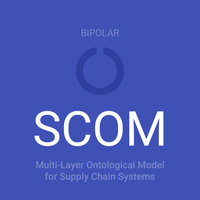SCOM
 SCOM by H. K. Ilter is licensed under a Creative Commons Attribution-NonCommercial-ShareAlike 4.0 International License.
SCOM by H. K. Ilter is licensed under a Creative Commons Attribution-NonCommercial-ShareAlike 4.0 International License.
From "A Multi-Layer Ontological Model for Supply Chain Systems" by H. K. Ilter, Ph.D. and A. A. Bulgak, Ph.D., P.Eng.:
"In the supply chain research field, the question of which ontological structure is suitable for describing a particular supply chain system is still unclear due to the complex architecture of such systems. As a result, there are often problems with the successful implementation of the ontological models. This article presents a multi-layer ontological model that describes a supply chain. The model has four basic conceptual layers of knowledge; namely the Product, Agent, Flow, and Operation layers. Developers can add more layers or sub-layers depending on the complexity of a particular supply chain. Our model will provide a perspective to the area of supply chain management by splitting industry-specific issues into these familiar ontological layers."
© 2014 H. K. Ilter
|
4. Operation Layer In the Operation Layer, there are various operations that can be observed such as plan, source, make, deliver, and return as indicated in the Supply Chain Council’s Supply Chain Operations Reference (2014).
Flow Layer shows relationships between agents by means of flow between nodes of the Agent Layer. The flows can be one of the three types; material, money, or information.
All agents of the supply chain (i.e., main producers, suppliers, extractors, gatherers, and transporters in the upstream and customers, consumers, distributors, and transporters in the downstream) are included in the Agent Layer.
Product Layer covers the information about goods and services which are created in the Operation Layer by agents and moving through the Flow Layer of the supply chain. |
SCOM Combined Layers SCOM, being a domain ontology, has four layers of knowledge: Product Layer, Flow Layer, Agent Layer and Operation Layer. Each layer has its own classes and properties. Layers of the model can be integrated by overlapping in a unified level of knowledge. Figure from Ilter, H. Kemal (2014): SCOM Layers. figshare. http://dx.doi.org/10.6084/m9.figshare.1040473 Retrieved 04:29, Sep 28, 2014 (GMT) |
